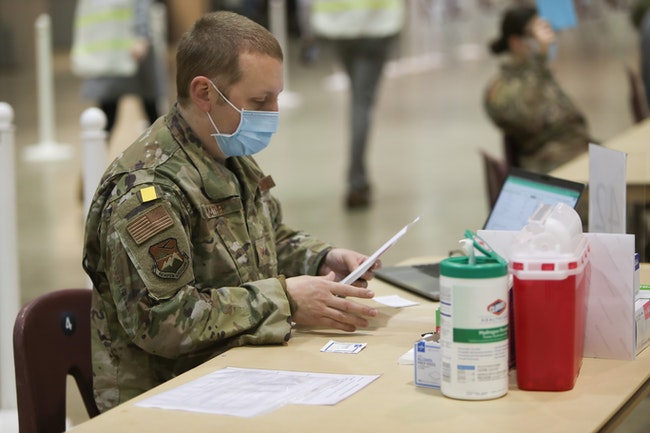
Oregon National Guard member Carson Mather readies his vaccination station for the next vaccine recipient during a COVID-19 vaccine clinic at the Oregon State Fairgrounds on Thursday, Jan. 28. (Amanda Loman/Salem Reporter)
Gov. Kate Brown announced on Friday the state was within striking distance of having most pandemic restrictions lifted once 70% of eligible Oregonians received their first dose of the Covid vaccine.
Currently, 66% of Oregonians have received at least their first dose, she said. Just 127,000 more Oregonians need to get their first dose to trigger the broad lifting of restrictions.
Once the target is met, Brown said restaurants and bars will again have full houses, people can eat popcorn in movie theaters, kids will return to classrooms in fall and the Pendleton Round-Up will resume. Businesses will no longer have capacity requirements, masks won’t be mandated in most places and physical distancing won’t be necessary, she said.
“By and large this means we will be able to return to the activities and traditions we have missed for more than a year,” Brown said during a press conference.
Oregon Health Authority Director Pat Allen said the state could meet the target by June 21, the first day of summer.
Once the threshold is met, the state will begin transitioning out of its emergency response to managing Covid like other diseases.
However, Brown cautioned that life won’t totally return to normal, and the state will be moving to another “chapter” of the pandemic.
Brown said the state will continue to follow federal masking guidelines and face coverings will likely be required in airports, hospitals and other settings. She also pointed out that children under 12 years are not currently eligible for the vaccines and that immunocompromised people are still vulnerable.
“Let’s respect one another as we prepare to make this transition,” she said.
Minority groups in Oregon have also faced barriers to medical care and are still not vaccinated at the same rate as their white counterparts, Brown said.
According to the most recent numbers from the Oregon Health Authority, about 48% of white Oregonians are partially or fully immunized. For Black and Hispanic/Latinx Oregonians, that percentage is a little over a third.
Oregon Health Authority Director Pat Allen said that the virus came “roaring back” in recent months and has subsided as more people became vaccinated.
“There isn’t one pandemic in Oregon, there are two,” he said. “One is a pandemic that is dying out among people who are vaccinated. And the other is a pandemic that is raging as fiercely as ever among people who are unvaccinated.”
He said the most recent numbers show that of the 16,097 Covid cases recorded in May, 98% were among those who were unvaccinated or not fully vaccinated. He added that the “data clearly show that if you are fully vaccinated, you can begin to put the pandemic behind you…”
Brown credited the increased vaccination rate to the “Take Your Shot, Oregon” campaign, which offers prizes to vaccinated Oregonians, including $1 million cash. Allen also said that partnering with community organizations and public health departments has also increased vaccinations.
Allen said that efforts to close the “vaccination gap” were paying off and over the past week vaccinations among Latinos increased 5%, Black Oregonians increased 5.4%, American Indian and Alaskan Native increased 5.2%, and Native Hawaiian and Pacific Islander communities increased 5%.
Dr. Dean Sidelinger, state epidemiologist and health officer, said hospitalizations are decreasing and the recent surge that began over the spring is declining. He said the seven-day average for case counts is 318 —61% lower than May 1. The number of people in the hospital with Covid has declined 31% since May 1, he said.
In the meantime, counties that see 65% of their eligible population receive their first dose and submit an approved plan to vaccinate minority communities will be moved into the “low-risk” category of restrictions.
The most recent numbers show that Marion County is at 57.3% with 20,888 more people to go. Polk County is at 62.2% with 1,826 left to go.
Contact reporter Jake Thomas at 503-575-1251 or [email protected] or @jakethomas2009.
JUST THE FACTS, FOR SALEM – We report on your community with care and depth, fairness and accuracy. Get local news that matters to you. Subscribe to Salem Reporter starting at $5 a month. Click I want to subscribe!









